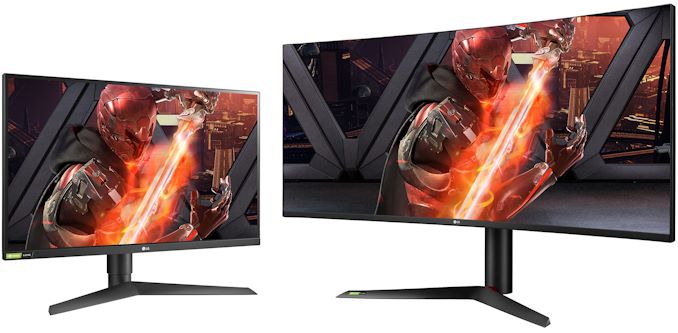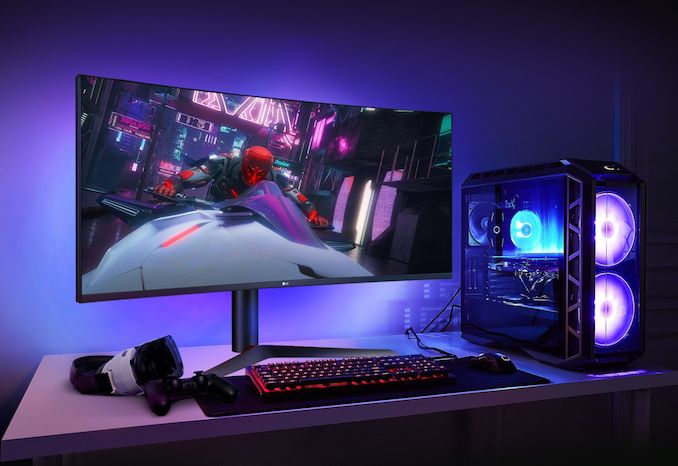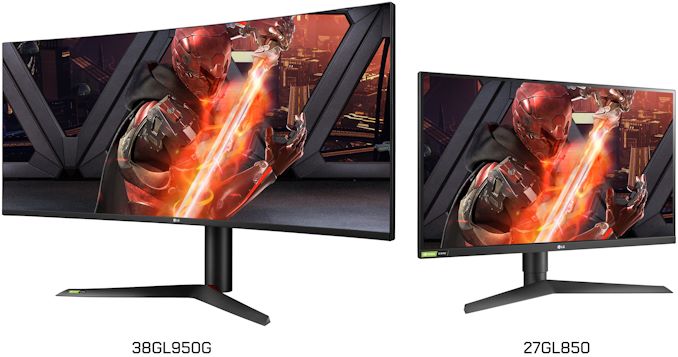LG Unveils 27 and 37.5-Inch IPS Monitors with 1 ms Response Time
by Anton Shilov on June 13, 2019 5:00 PM EST
LG has introduced the industry’s first IPS displays featuring a 1 ms response time. The new UltraGear monitors bring together high image quality that LG’s Nano IPS panels are known for, the DCI-P3 color gamut, high performance, and NVIDIA G-Sync support. Aimed primarily at gamers, the new UltraGear monitors will come in 27-inch and 37.5-inch sizes.
The smaller monitor is the LG UltraGear 27GL850 that uses a 27-inch IPS panel featuring a 2560×1440 (16:9) resolution, 350 nits brightness, a 144 Hz refresh rate, and 1 ms GtG response time. The larger display is the UltraGear 38GL950G based on a 37.5-inch panel offering a wider aspect ratio 3840×1600 (21.5:9) resolution, 450 nits brightness, a 175 Hz refresh rate (when overclocked), and also a 1 ms response time. The smaller monitor supports HDR10, whereas the bigger one is DisplayHDR 400 certified.
Both UltraGear 27GL850 and UltraGear 38GL950G LCDs can display 1.07 billion colors and cover 98% of the DCI-P3 color gamut, a very good result for gaming-grade monitors. The two displays also feature LG’s Nano IPS panels featuring a special nanoparticle cover applied to the screen’s LED backlighting to fine-tune its spectral output to absorb surplus light wavelengths and increase intensity, purity, as well as the accuracy of the on-screen colors.
Since LG’s UltraGear displays are designed primarily for gamers, both support a number of features aimed at this audience. Apart from NVIDIA’s G-Sync dynamic refresh rate technology, the new LCDs also support LG’s Dynamic Action Sync mode, Black Stabilizer, and Crosshair functions. Besides, the larger display supports LG’s Sphere Lighting 2.0 technology.
As far as connectivity is concerned, both LG’s UltraGear 27GL850 and UltraGear 38GL950G monitors feature DisplayPort and HDMI inputs, as well as a dual-port USB 3.0 hub. Meanwhile, they have neither a headphone jack nor integrated speakers.
| The LG UltraGear-Series Displays | |||
| 27GL850 | 38GL950G | ||
| Panel | 27" IPS | 37.5" IPS | |
| Native Resolution | 2560 × 1440 (16:9) |
3840 × 1600 (21.5:9) |
|
| Refresh Rate | 144 Hz | Native: ? Hz Overclocked: 175 Hz |
|
| Dynamic Refresh Rate | Technology | NVIDIA G-Sync compatible | NVIDIA G-Sync |
| Range | ? | ? | |
| Response Time | 1 ms (gray-to-gray) | ||
| Brightness | 350 cd/m² | 450 cd/m² | |
| Contrast | ? | ||
| Color Gamut | 125% sRGB 98% DCI-P3 |
||
| Viewing Angles | 178°/178° horizontal/vertical (?) | ||
| Curvature | none | curved | |
| Inputs | 1 × DisplayPort 1.2 2 × HDMI 2.0 |
1 × DisplayPort 1.2 1 × HDMI 2.0 |
|
| USB Hub | 2 × USB 3.0 Type-A | 2 × USB 3.0 Type-A | |
| Audio | none | ||
| Proprietary Enhancements | Dynamic Action Sync mode, Black Stabilizer, Crosshair |
||
| Stand | Height | ? | |
| Tilt | ? | ? | |
| Swivel | ? | ? | |
| Power Consumption | Idle | ? | |
| Typical | ? | ||
| Maximum | ? | ||
LG plans to start sales of the UltraGear 27GL850 display in the third quarter with pre-orders in the US starting on July 1, 2019. LG does not disclose pricing of either UltraGear 27GL850 or UltraGear 38GL950G monitors, but without any doubts both will belong to the company’s premium family of products.
Related Reading:
- LG Unveils UltraGear 34GK950 34-Inch Curved Gaming Displays with Nano-IPS
- LG to Demo UltraWide 38-Inch 144Hz Gaming & 49-Inch Workstation Displays at CES
- LG Launches Midrange 32UL750-W Monitor: DisplayHDR 600 with FreeSync & USB-C For $750
Source: LG












49 Comments
View All Comments
HStewart - Thursday, June 13, 2019 - link
Does anybody know the price on these, I have a 38 u 88 at same relation - my guess these are probably high end - I pad around $619.but love it.HStewart - Thursday, June 13, 2019 - link
Just 3440 X 1440 which 34in - so this one probably a lot more - FreeSync but not sure my Dell XPS 15 2in1 supports even though GPU shouldDiji1 - Friday, June 14, 2019 - link
All the 34" 3440x1440 100Hz (120 OC) monitors prices have been tumbling recently though.imaheadcase - Thursday, June 13, 2019 - link
My source said the 38 inch will be $1800 USD. Which added Gsync and high but panel is kinda cheap actually. I have the Dell version of the IPS at 3840 × 1600 and was around $999. So "only" a $800 premium refresh rate could be worth it...if you got a card that can drive it.Hxx - Thursday, June 13, 2019 - link
if you trust a german site that posted similar info on the 37.5 inches (hardwarelux.de I believe) about a month ago, the price will be roughly 2K Euros. So around $2K in the US.Old_Fogie_Late_Bloomer - Thursday, June 13, 2019 - link
It's 21.6:9, unless "21.5:9" is some horrible new marketing compromise I've yet to hear about.Old_Fogie_Late_Bloomer - Thursday, June 13, 2019 - link
Also, I'm so f--king tired of everything being a multiple of 9. It's 3840:1600, literally half again as wide as 2560x1600 (16:10), and should be called 24:10.mode_13h - Thursday, June 13, 2019 - link
Heh, don't be such an old fogie, late bloomer!I guess the argument for using a denominator of 9 is to make aspect ratios more directly comparable. However, I'd rather drop the fractional notation and just use decimal. Now that pixels are always square, it's easily computed by just dividing the width by the height of the native resolution. For instance, 1.78 ~= 16:9 and 2.35 is a common cinema aspect ratio.
piroroadkill - Friday, June 14, 2019 - link
Exactly. Decimal. way better.Old_Fogie_Late_Bloomer - Friday, June 14, 2019 - link
I'm down with the decimal notation, but it's worth mentioning that x:10 aspect ratios are essentially decimal notation. Just move the decimal point of x one place to the left and you're done.It's all hypothetical, though, since I don't see the fetish for 9 going away any time soon.